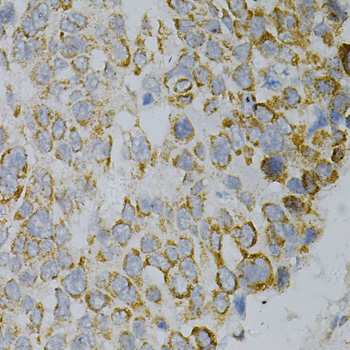Description
Anti-GNAO1 Antibody (CAB2510)
The GNAO1 Polyclonal Antibody (CAB2510) is specifically designed for research involving the GNAO1 protein, which is a critical signaling molecule in the nervous system. This antibody, produced in rabbits, has high reactivity with human samples and has been validated for use in Western blot applications. By binding to the GNAO1 protein, this antibody enables accurate detection and analysis in a variety of cell types, making it an ideal tool for studies in neuroscience and neurology research.GNAO1 is a G protein subunit that plays a key role in neurotransmission and neuronal development. Mutations in the GNAO1 gene have been linked to various neurological disorders, including epilepsy and movement disorders.
By understanding the function of GNAO1, researchers can gain valuable insights into the mechanisms underlying these disorders and potentially develop targeted therapies to treat them.Overall, the GNAO1 Polyclonal Antibody (CAB2510) is a valuable resource for researchers investigating the role of GNAO1 in the nervous system and its implications for disease. Its high specificity and sensitivity make it a reliable tool for studying the intricate signaling pathways that govern neuronal function.
| Antibody Name: | Anti-GNAO1 Antibody |
| Antibody SKU: | CAB2510 |
| Antibody Size: | 20uL, 50uL, 100uL |
| Application: | WB IHC |
| Reactivity: | Human, Mouse |
| Host Species: | Rabbit |
| Immunogen: | Recombinant fusion protein containing a sequence corresponding to amino acids 60-180 of human GNAO1 (NP_066268.1). |
| Application: | WB IHC |
| Recommended Dilution: | WB 1:500 - 1:2000 IHC 1:50 - 1:200 |
| Reactivity: | Human, Mouse |
| Positive Samples: | Mouse brain, Mouse spinal cord |
| Immunogen: | Recombinant fusion protein containing a sequence corresponding to amino acids 60-180 of human GNAO1 (NP_066268.1). |
| Purification Method: | Affinity purification |
| Storage Buffer: | Store at -20'C. Avoid freeze / thaw cycles. Buffer: PBS with 0.02% sodium azide, 50% glycerol, pH7.3. |
| Isotype: | IgG |
| Sequence: | GFSG EDVK QYKP VVYS NTIQ SLAA IVRA MDTL GIEY GDKE RKAD AKMV CDVV SRME DTEP FSAE LLSA MMRL WGDS GIQE CFNR SREY QLND SAKY YLDS LDRI GAAD YQPT EQDI LRTR V |
| Gene ID: | 2775 |
| Uniprot: | P09471 |
| Cellular Location: | Cell membrane, Lipid-anchor, Membrane |
| Calculated MW: | 40kDa |
| Observed MW: | 39kDa |
| Synonyms: | GNAO1, EIEE17, G-ALPHA-o, GNAO, HLA-DQB1, NEDIM |
| Background: | The protein encoded by this gene represents the alpha subunit of the Go heterotrimeric G-protein signal-transducing complex. Defects in this gene are a cause of early-onset epileptic encephalopathy. Two transcript variants encoding different isoforms have been found for this gene. |
| UniProt Protein Function: | G-alpha(o): Guanine nucleotide-binding proteins (G proteins) are involved as modulators or transducers in various transmembrane signaling systems. The G(o) protein function is not clear. Stimulated by RGS14. Interacts with RGS14. G proteins are composed of 3 units; alpha, beta and gamma. The alpha chain contains the guanine nucleotide binding site. Belongs to the G-alpha family. G(i/o/t/z) subfamily. 2 isoforms of the human protein are produced by alternative splicing. |
| UniProt Protein Details: | Protein type:G protein, heterotrimeric alpha G((i/o/t/z)); G protein; G protein, heterotrimeric Chromosomal Location of Human Ortholog: 16q13 Cellular Component: neuron projection; plasma membrane; heterotrimeric G-protein complex Molecular Function:corticotropin-releasing hormone receptor 1 binding; GTPase activity; signal transducer activity; GTP binding; mu-type opioid receptor binding; metal ion binding; G-protein beta/gamma-subunit binding; GTPase activating protein binding; metabotropic serotonin receptor binding Biological Process: G-protein signaling, coupled to cAMP nucleotide second messenger; response to drug; negative regulation of calcium ion transport; response to hydrogen peroxide; muscle contraction; metabolic process; response to cytokine stimulus; forebrain development; dopamine receptor signaling pathway; response to morphine; locomotory behavior; neurite development; regulation of heart contraction; positive regulation of GTPase activity; aging Disease: Epileptic Encephalopathy, Early Infantile, 17 |
| NCBI Summary: | The protein encoded by this gene represents the alpha subunit of the Go heterotrimeric G-protein signal-transducing complex. Defects in this gene are a cause of early-onset epileptic encephalopathy. Two transcript variants encoding different isoforms have been found for this gene. [provided by RefSeq, Aug 2015] |
| UniProt Code: | P09471 |
| NCBI GenInfo Identifier: | 232133 |
| NCBI Gene ID: | 2775 |
| NCBI Accession: | P09471.4 |
| UniProt Related Accession: | P09471 |
| Molecular Weight: | |
| NCBI Full Name: | Guanine nucleotide-binding protein G(o) subunit alpha |
| NCBI Synonym Full Names: | G protein subunit alpha o1 |
| NCBI Official Symbol: | GNAO1 |
| NCBI Official Synonym Symbols: | GNAO; NEDIM; EIEE17; HLA-DQB1; G-ALPHA-o |
| NCBI Protein Information: | guanine nucleotide-binding protein G(o) subunit alpha |
| UniProt Protein Name: | Guanine nucleotide-binding protein G(o) subunit alpha |
| UniProt Gene Name: | GNAO1 |
| UniProt Entry Name: | GNAO_HUMAN |




















